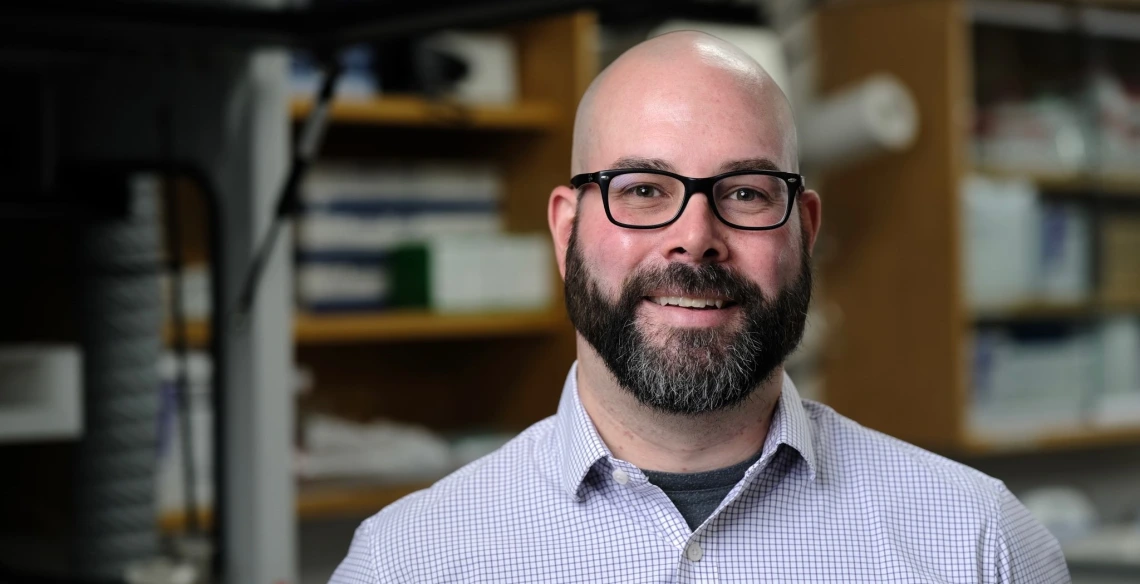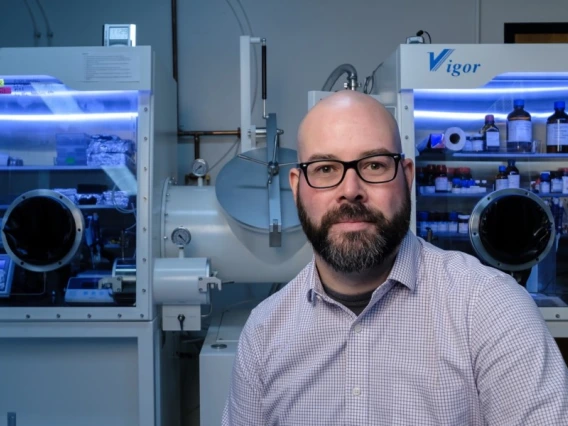Ink Dries on Printable Electronics DOE Award for UA Professor
Printable electronics could enable technologies like highly efficient thin-film solar power and rollable LED screens, but determining how to print these films at manufacturing scale is still a work in progress. A chemical engineering professor is...

Adam Printz, an assistant professor of chemical and environmental engineering, has received an $875,000 award from the Department of Energy Office of Science Early Career Research Program.
Printable electronics are a hot topic.
Through printing, electronic devices can now be built on flexible or form-fitting substrates, making it possible to produce ultrathin, rollable televisions, or to coat buildings with a thin film that generates solar power. However, these printable electronics aren’t yet widely used, in part because they are difficult to manufacture at scale.
With an $875,000 award from the Department of Energy Office of Science Early Career Research Program, Adam Printz, an assistant professor of chemical and environmental engineering at the University of Arizona, is examining the fundamental characteristics of a new printing process his team developed that could significantly advance the field. This process, which his team began developing several years ago, is called restricted area printing by ink drawing, or RAPID.
Much of the field’s research to date has focused on improving established printing techniques, which don’t yet offer commercial viability. While there are other emerging printing techniques that also show promise, there is still much about the fundamental processes that scientists don’t understand.
“Right now, a lot of the work is optimization driven, meaning it’s very much a process of ‘Try this temperature, try this print speed, and see what we get,’” Printz said. “If we have a deep understanding of the fundamentals of these processes, that will allow us to predict what will happen under different conditions and give us the control necessary to print high-quality electronic devices.”
Zooming in on RAPID
Current-state-of-the-art printing methods involve spreading ink onto a substrate, or a plate. Printz’s approach, RAPID, limits the ink to a confined space by placing a second plate atop it. Think of current methods like a knife spreading jam on toast, while RAPID is more like a high-tech sandwich that uses a second piece of toast on top to spread the jam. By confining the ink between two pieces of “toast,” the ink solvent’s evaporation is more controlled, enabling easier printing of high-quality films.
But now, Printz and his team are taking things back to basics, examining crystal formation from the RAPID printing process at a fundamental level. How do these inks behave during the printing process? What do the crystals in the resulting films look like, and how do different printing conditions influence the crystal growth? They plan to research three primary areas.
Research Area 1: Bulk Versus Surface
In general, the surface onto which an ink is printed is more thermodynamically favorable for crystal nucleation (meaning crystals grow more easily there) compared to the ink’s bulk. Thus, scientists hypothesize that if more of the ink relative to its volume is in contact with a surface, the rate of nucleation will be higher.
To test this hypothesis, Printz’s team will confine ink between two plates and change the distance between them – moving them closer together to reduce the ink volume and increase the ratio of surface area to bulk, or moving them farther apart to increase the ink volume and reduce the ratio of surface area to bulk. Think of our jam sandwich again — we could have either a very thin or thicker layer of jam in between our pieces of toast. Essentially, the team expects that changing the thickness of the “jam” will significantly change the qualities of the printed films.
“If we hold the surface area of the ink constant, but change the ink volume, all observed differences in the rate of nucleation should be driven by the volume change,” Printz said. “So then, we can figure out the crystallization rate in the bulk of the solution, and from there, the crystallization rate at the surfaces. This experiment should give us a lot of information about our system.”
Research Area 2: Unraveling Growth Patterns
The team also wants to understand the growth patterns of crystals in these films.
Some films grow evenly, layer by layer. With others, separate islands of crystals form and converge. Some films initially grow layers and then islands. These growth processes are understood when films are grown using other techniques, but less understood when it comes to thin-film growth from solutions. Understanding all the factors that drive growth from one mode to another could allow them to eventually control the way films grow and evoke specific properties.
“Rather than just saying, ‘With this system, the film grows one way and with that system, the film grows another way,’ we want to be able to deterministically control the growth,” Printz said. “And to control it, you have to understand it.”
These experiments will involve varying a wide range of parameters that can affect crystal formation, including solute concentration, solvent properties and temperature.
Research Area 3: Surface Chemistry Versus Surface Energy
The team will also examine the relationship between the substrate surface energy, which influences how well the ink wets the surface, and surface chemistry, which could influence the rate of crystal nucleation through molecular interactions with the ink. These two properties are closely related, but Printz and his team want to decouple them to determine how each influences film growth separately.
“To visualize how you could have surfaces with the same surface energy, but other properties that are different, imagine you have a piece of metal painted half black and half white,” Printz said. “If you put water on that surface, the water’s going to wet the whole surface the same – the surface energy is the same across the board. But if you were to shine a light on it, the white side is going to reflect the light off and the black side is going to absorb it. So, even though the surface energy is the same, the behavior is going to be a little bit different.”


